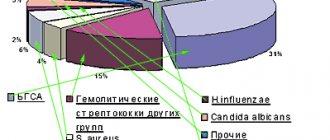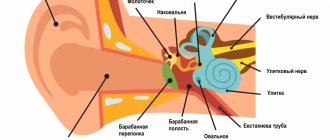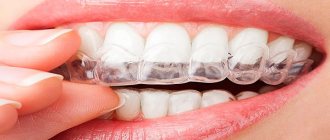Author:
- Elena Vitalievna Naumova, otolaryngologist, leading doctor of the clinic
2.82 (Votes: 11)
Acute tonsillitis with purulent exudate is considered the most common infection.
The disease occurs in both adults and children due to the entry of pathogenic microbes and bacteria into the oral cavity. It is not difficult to get a purulent sore throat even in the absence of direct contact with a sick person. Bacteria are spread through contact and airborne transmission, such as by sneezing or coughing in a public place or sharing household items.
Forms of purulent sore throat
There are two varieties:
- Purulent sore throat, affecting the lacunae of the tonsils. The infection is localized in the upper part of the throat and does not penetrate deeper. Purulent deposits are easily separated with a spatula.
- Purulent tonsillitis affecting the lymph nodes. The infection penetrates deeper and affects the lymphoid apparatus. Purulent exudate cannot be separated manually. The condition is extremely serious and threatens the formation of a peritonsillar abscess. Urgent medical attention and hospitalization are required.
Complications of sore throat
During the disease, the infection can spread to neighboring organs, causing otitis media, lymphadenitis, sinusitis, and peritonsillitis. Among the local purulent complications of tonsillitis, one can note the formation of an abscess or phlegmon in the inflamed tissues. Their occurrence is accompanied by a new wave of fever, increasing sore throat, problems with swallowing and breathing. In the case where the pathology is caused by streptococcus, 3-4 weeks after clinical recovery, glomerulonephritis, reactive arthritis or rheumatic carditis may develop due to subsequent autoimmune processes.
Causes of sore throat (acute tonsillitis)
The accumulation of purulent “sacs” in the tonsils occurs for various reasons. The main causative agents of tonsillitis are streptococci, but viral and fungal pathogens, staphylococci and pneumococci are also found. If the body is healthy, then the infection will not develop, but the following factors can aggravate the condition:
- Injuries to the tonsils and nasopharynx.
- Weak immunity.
- Chronic diseases of the ear, nose and throat, for example, stomatitis, caries, rhinitis, etc. foci of infection increase the proliferation of pathogens.
- Local and general hypothermia, for example, eating ice cream or drinking cold water.
- Autumn-spring vitamin deficiency.
The pathogenic factor penetrates deep into the tissues of the tonsils, forming a focus of infection.
Forms of the disease
The form of purulent tonsillitis depends on many associated factors and conditions. The most common three forms of development are follicular, lacunar and ulcerative-membranous (necrotic). Each type is characterized by characteristics of the course, specific lesions of the tonsil tissue and varying duration.
Follicular
Follicular tonsillitis is manifested by pinpoint purulent lesions of the parenchyma of lymphoid tissue and follicles of the tonsils. The disease in 85% of cases is caused by group A streptococci. The remaining cases of infection are associated with staphylococcal infection, Haemophilus influenzae, pneumococcus, and adenovirus. This form of pathology is accompanied by a rapid increase in the symptom complex, severe hyperthermia, sweating, loss of sleep and appetite. Intense pain in the throat can radiate to the ear.
Lacunarnaya
This type of disease causes severe inflammatory damage to the tissues of the peripharyngeal ring. The opening of abscesses is accompanied by the formation of specific perforations on the surface of the tonsils - lacunae. The acute phase of the disease is manifested by an increase in the size of the tonsils, up to difficulty breathing. Along with other symptoms, a characteristic sign of the lacunar type of pathology is bad breath. Sometimes doctors note a noticeable change in voice and diction problems. Inadequate therapy can lead to the development of a paratonsillar or retropharyngeal abscess.
Necrotic
Necrotizing ulcerative tonsillitis is rare (about 5-6% of cases). The main cause of the development of this type of disease is fusospirochetous infection. The rapid development of the infectious-inflammatory process causes the formation of histological changes in the tissues of the palatine tonsils. Violations of vascular permeability, associated with the active production of histamine and cytokines, lead to hypertrophy and sometimes tissue necrosis. The first sign of the disease is the feeling of a “lump in the throat.” Later, a sharp, unpleasant putrid odor appears from the mouth and salivation increases.
Clinical picture
Once a pathogen enters the body, two hours are enough for it to spread. Streptococci settle on the tonsils, weakening local immunity. The incubation period varies from several hours to 5 days.
The main differences between purulent tonsillitis are symptoms:
- A sharp pain in the throat occurs, which causes discomfort even at rest. The next day she becomes unbearable when talking or eating.
- Within a few hours, the body temperature rises to 39-40°C. Against the background of high temperature, it throws you either hot or cold, sweating increases and chills are present.
- Swallowing saliva causes severe, sharp pain.
- There is not enough air when breathing due to swelling of the tonsils.
- When examined with the naked eye, swollen tonsils and severe hyperemia of the back wall of the throat are visible. The next day the tongue and palate swell.
- There is a sensation of a foreign body in the nasopharynx, which intensifies when saliva is swabbed.
- Due to the fact that the tonsils are well supplied with blood, a yellowish-white dot appears on them, the boundaries of which quickly expand. The next day, the throat may become covered with many white purulent dots, which gradually merge into large ulcers.
Purulent tonsillitis in children occurs in a more severe form. Due to the excessive pressure of the swollen lymphoid tissue of the adenoids on the Eustachian tubes, the ears become blocked and there is tinnitus. If treatment is not attempted, the infection can spread to the ears, complicated by otitis media.
Usually the acute period lasts no more than one week if treatment is prescribed on time.
Important to know and remember! Purulent tonsillitis is a dangerous infectious disease, so the patient should be immediately isolated from household members.
Incubation period
The period from the moment the pathogen enters the body until the appearance of the first characteristic symptoms can range from 2 to 6 days. During the first few days, the sick person is still unaware of his condition, becoming a source of infection for others. During the incubation period, the infection is actively transmitted by airborne droplets (through coughing, sneezing, kissing, talking). The onset of the disease is manifested by a feeling of chills, increased body temperature, weakness and headache. The sooner the patient sees a doctor, the easier the treatment is.
Treatment of purulent sore throat
Purulent tonsillitis threatens serious complications from the heart, kidneys, joints and soft tissues of the neck if therapy is chosen incorrectly or treatment is started late. It is for this reason that it is important to immediately consult a doctor when the first signs of a sore throat appear.
The basic treatment regimen for acute tonsillitis with purulent exudate:
- Taking antibiotics of the penicillin group or the macrolide group. You can't do without them. General and local remedies are prescribed. Antibiotics kill pathogenic microflora and after a few days the production of pus stops, blood circulation in the tonsils is restored.
- Taking anti-inflammatory lozenges, lozenges, lozenges.
- Gargling and irrigating the throat with different solutions every hour.
- Use of local antiseptics in the form of a spray.
- Taking antipyretic drugs.
- Vitamin therapy and taking immunomodulators.
The principle of treatment of acute tonsillitis in children is similar, the only differences are in the dosage of medications. The patient needs to observe strict bed rest, talk less and gargle more often.
If the prescribed drug therapy does not have positive dynamics within several days, the patient continues treatment in the hospital.
Due to the presence of purulent plaque on the palatine tonsils, eating is difficult or completely impossible, so you can eat only pureed and liquid food, and also drink a lot of warm water to relieve symptoms of intoxication.
Main groups of drugs
Sore throat is provoked by different types of opportunistic microorganisms and treatment depends on the specific causative agent of the disease. First of all, the ENT doctor will give a referral for a blood test and bacterial culture from the tonsils to detect antibiotic resistance.
Most often, purulent tonsillitis is treated with systemic antibiotics:
- Penicillin series. They have fewer contraindications, so they are often prescribed to children and adults with intolerance to other groups of antibiotics. Penicillins are effective only at the initial stage, when ulcers have not formed. It is worth noting that they are not prescribed if the patient has a history of bronchial asthma or urticaria. During pregnancy, they are prescribed only when absolutely necessary in the early stages.
- Cephalosporins. They are beneficial in severe cases of the disease. They are low toxic and effective from the first day of use. Can be prescribed to pregnant women.
- Macrolides. Prescribed if there is no effect from taking medications of the first two groups. Macrolides have an extended list of contraindications and are taken in a short course. It is worth noting that they are prohibited during pregnancy and breastfeeding.
- Lincosamides. Used for frequent exacerbations of purulent tonsillitis.
General therapy should be comprehensive, i.e. It is possible to speed up recovery and remove the pathogen with oral antibiotics and local treatment. Local antibiotics for purulent sore throat are prescribed to young children and pregnant women.
Prohibited methods of treatment for purulent sore throat
Unfortunately, patients often make independent treatment attempts, which only worsen the clinical picture. The following actions are prohibited:
- Pierce the ulcers with sharp objects.
- Push out, tear off or squeeze out ulcers.
- Treat tonsils with hydrogen peroxide, Lugol's solution, iodine.
- Warm your throat and gargle with hot water.
- Rinse with vinegar and concentrated alcohol solution.
- Apply compresses of vodka and alcohol to the throat.
Important to remember! It is very dangerous to try to remove purulent deposits on your own.
At the ENT CLINIC in Chertanovo, otolaryngologists immediately help patients. They carry out non-contact removal of purulent plaque using ultrasound on the CAVITAR device (USOL therapy). Pharyngoscopy and smear analysis are performed to determine sensitivity to antibiotics in order to prescribe an effective medicine. Specialists use modern drugs of the latest generation to improve the patient’s condition. Based on the severity of the disease, individual characteristics, and age of the patient, the clinic’s ENT doctor prescribes medications and gives recommendations for treating purulent tonsillitis at home.
Causes of sore throat
Most often, inflammation is caused by the activity of beta-hemolytic streptococcus group A. Among the possible causative agents of the disease are also adenovirus, staphylococci, pneumococci, parainfluenza virus, mycoplasma, chlamydia, rhinovirus, respiratory syncytial virus, spirochete, Epstein-Barr virus, diphtheria bacillus, enterovirus Coxsackie B, fungi.
The risk of developing a sore throat increases when exposed to the following factors:
- general or local hypothermia;
- weakened immunity due to acute respiratory infections;
- fungal diseases;
- chronic pathologies of the nasopharynx, difficulty in nasal breathing, purulent processes and inflammation in the paranasal sinuses;
- caries;
- systematic exposure to irritating substances on the body, work in a smoky or dusty room;
- increased air dryness;
- regular drinking of alcohol, smoking;
- acute and chronic intoxication;
- poor nutrition, lack of vitamins in the diet.
Treatment of sore throat at home with compresses.
- Compress with soap. Lather damp gauze with laundry soap and tie it to the throat, insulate the top with a dry, warm cloth, and leave overnight. When treating children, keep the compress for 3 hours. Significant relief from using this folk remedy occurs in the morning. In the morning, wash your neck with warm water and lubricate with nourishing cream.
- Saline dressing. Fold a wide bandage into 6 layers, moisten it in a 10% salt solution, apply it to the throat and neck, put 2 layers of dry cloth on top, preferably a cotton scarf, keep it on all night. The sore throat goes away overnight. (Healthy Lifestyle 2002, No. 10 p. 16) (Healthy Lifestyle 2004, No. 16, p. 23)
- You can cure a sore throat in 1 day with a homemade compress of honey and mustard. Mix 1 tbsp. l. honey, 1 tbsp. l. dry mustard and 1 tbsp. l. flour, make a flat cake from the resulting dough and place it on your throat, with plastic and a warm scarf on top. Apply a compress at night, in the morning the pain will go away and the temperature will subside. (Healthy Lifestyle 2003, No. 22, p. 6), (Healthy Lifestyle 2010, No. 5, p.

- Treatment of the throat with a cabbage compress. Grate the cabbage, wrap it in gauze and strengthen the compress on the neck by placing compress paper on top and wrapping the neck with a terry towel. Keep for 1-2 hours. After the compress, the pain will immediately subside. (HLS 2003, No. 1, p. 20)
- Compresses with lard. Cut unsalted lard into thin slices, place the slices on the throat, cover with parchment paper, cotton wool on top, wrap with a scarf, and on top with a shawl or scarf. This compress is done at night; it should be repeated the second night, although the pain will go away after the first compress. (HLS 2006, No. 6, p. 30)
Prevention measures
Is strep throat contagious to others? Yes, with tonsillitis the main route of transmission of infection is airborne. Infection occurs from a sick person or a carrier of pathogenic bacteria. Therefore, to prevent infection, it is necessary:
- reduce contact with a sick person to a minimum;
- use personal utensils (a person with a sore throat is given a separate cup, plate, fork and spoon).
Prevention measures also include general principles of addressing risk factors:
- promptly treat acute respiratory infections, the first sign of which is a runny nose;
- visit the dentist regularly to detect and treat caries in a timely manner;
- give up passive and active smoking.
Prevention and precautions when communicating with a patient
- Clothes must be worn appropriately for the weather conditions to completely prevent hypothermia.
- Regularly scheduled visits to the dentist will prevent large-scale development of caries and neutralize small foci of infection.
- Quitting nicotine, drug addiction and alcohol will restore the body's defenses.
- Sports activities will strengthen the immune system.
- Having proper rest and healthy food significantly improves metabolic processes.
- During seasonal epidemics, it is advisable to avoid attending public events.
When communicating with a patient with purulent tonsillitis, you should wear a cotton-gauze bandage, and also practice preventive gargling, using nasal ointments.
If therapy is carried out at home, it is important to clean the room every day using disinfectant solutions and periodically ventilate the room
Prevention of sore throat in pictures
Contraindications for sore throat
Sore throat is a disease that cannot be carried on your feet. Even in cases where it occurs in a mild form. This can trigger the infection to become chronic or severe, and also contributes to complications.
If you feel better, you should not stop taking antibiotics. It is also not recommended to smoke or drink alcohol, as smoke and alcohol can irritate a sore throat. It is necessary to exclude fatty, spicy, sour and solid foods from the diet for the same reason - so as not to irritate the throat.
It is extremely important to completely cure the disease so that it does not become chronic. Otherwise, you will face the fact that the infection will torment you regularly.
Diagnosis of sore throat
At the patient’s initial visit, the doctor collects complaints and anamnesis, specifying the duration and circumstances of the onset of symptoms, and the nature of the pain.
This is followed by a general examination of the patient, a visual assessment of the mucous membranes of the mouth and throat, and palpation of regional lymph nodes. An endoscopic examination of the ENT organs – pharyngoscopy – is mandatory. It allows you to examine the tonsils in detail and thus determine the form of the disease. For angina, the following tests are prescribed:
- Clinical blood test. Inflammation is indicated by neutrophilic leukocytosis with a shift to the left and accelerated ESR.
- General urine analysis. It is possible that protein may appear in the biomaterial.
- Rapid test from the tonsils using diagnostic strips to detect group A beta-hemolytic streptococcus.
- Bacteriological examination of a smear for beta-hemolytic streptococcus and diphtheria. Material is collected from the surface of the palatine tonsils and the posterior wall of the oropharynx before using local antiseptic drugs and taking antibiotics.
- If a patient is suspected of having infectious mononucleosis, a blood test is performed to test for IgM antibodies or to identify the genetic material of the Epstein-Barr virus.
- As part of the diagnosis of herpetic sore throat, enterovirus RNA is determined in the blood and throat smear using the PCR method.
Diagnosis of complications of angina after clinical recovery includes the following laboratory and instrumental studies:
- Control general analysis of blood and urine.
- Rheumatic test. Determination of rheumatoid factor, C-reactive protein, antistreptolysin-O, seromucoid in the blood.
- ECG. The electrocardiogram may show signs of hypoxia and conduction disturbances.
Treatment of chronic tonsillitis
Chronic tonsillitis is treated using both conservative and surgical methods.
Conservative methods are:
- antibiotics that are prescribed both locally (gargling) and systemically (tablet or injection forms);
- direct washing of lacunae and introduction of antibacterial and anti-inflammatory drugs into them;
- physiotherapeutic procedures (hallotherapy, magnetic laser treatment of lymph nodes, phonophoresis and ultraviolet irradiation of the palatine tonsils).
| Treatment method | Mechanism of action | Target |
| Irrigation of lacunae using a cannula | The lacunae are cleaned of pus, microorganisms, food debris, and epidermal plugs using a jet of antiseptic solution. In the future, an antibacterial and anti-inflammatory drug may be administered | Cleansing lacunae Bactericidal effect Anti-inflammatory effect |
| Washing lacunae using a vacuum nozzle | Due to the action of vacuum, the contents are removed from the lacunae. | Cleaning gaps |
| Magnetic laser therapy (MILTA) | The effect of a magnetic field and laser radiation on the area of inflammation. The microcirculation of the affected area improves, and the local protective properties of the mucous membrane are activated. | Anti-inflammatory effect Activation of local immunity |
| Phonophoresismedicines | The effect of drugs (antibacterial, anti-inflammatory) on the mucous membrane of the tonsils. Under the influence of ultrasound, drugs penetrate into the deep sections of the lacunae. | Anti-inflammatory effect Bactericidal effect |
| Ultraviolet radiation (UV) | Ultraviolet radiation has a bactericidal effect and activates local immunity of the mucous membrane. | Bactericidal effect Activation of local immunity |
Surgical treatment methods:
- Tonsillectomy – removal of the tonsils along with the capsule (instrumental and bloodless technique).
- Destruction of lymphoid tissue in the tonsil (radio wave ablation, cryodestruction).
- Cryptolysis (“soldering” of palatal lacunae).
| Method of therapy | Mechanism of action | Advantages | Indications |
| Tonsillectomy performed with traditional instruments (instrumental) | Isolation of the tonsil and its capsule is carried out with surgical instruments (loop, raspatory) | Speed of surgery | Previous treatment was ineffective. Beta-hemolytic streptococcus was detected. Toxic-allergic form of tonsillitis. |
| Tonsillectomy bloodless | The tonsil is released from the capsule using a laser, radio wave, cold plasma energy or other physical methods | Simultaneous dissection and coagulation of tissue. The intervention is bloodless | Previous treatment was ineffective. Beta-type hemolytic streptococcus was detected. Toxic-allergic form of tonsillitis. |
| Destruction (ablation) of the lymphoid elements of the tonsil | Radio waves, laser, high or low temperatures destroy most of the lymphoid structures of the tonsils | Can be carried out in a clinic setting | Previous treatment was ineffective Simple (catarrhal) form of tonsillitis |
| Cryptolysis | Destruction of the epithelial layer of lacunae due to physical methods of influence. Under such conditions, they stick together, so food particles and microorganisms do not penetrate there, i.e. inflammation cannot develop. | Can be carried out in outpatient settings | Previous treatment was ineffective Simple (catarrhal) form of tonsillitis |
Types of sore throat
Sore throat differs in the degree of damage to the tonsils:
- catarrhal - the easiest option, in this case the inflammatory process affects only the mucous membrane, the tonsils are swollen and bright red
- lacunar – damage to the canals of the tonsils (lacuna), the tonsils are covered with a characteristic white coating;
- follicular - follicles are formed in the tonsils, which are filled with pus;
- combined - a severe form of tonsillitis, when both lacunae and follicles are affected on the tonsils.










